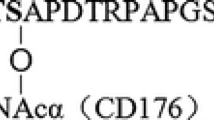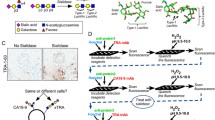Abstract
We studied the immunohistochemical expression of mucins (MUC1, underglycosylated MUC1, MUC2, MUC5AC, and MUC6), simple mucin antigens (Tn, sialyl Tn, and T), and histo-blood group antigens (type 1—Lewisa and sialyl Lewis;a type 2—Lewixx and sialyl Lewisx) in a series of 26 papillary thyroid carcinomas (PTC), 6 follicular carcinomas, and a control group of 32 cases of “normal” thyroid parenchyma adjacent to the tumors.
PTC expressed more often, more intensively, and more extensively every antigen but MUC6, which was not observed in any case. The expression of MUC5AC was also extremely rare. MUC1 expression was related to the expression of underglycosylated MUC1, MUC2, Lewis,a and sialyl Lewis.a A trend toward an association between the expression of MUC1 and that of type 2 histo-blood group antigens was also observed. Whenever there was a dissociation between the expression of type 1 and type 2 Lewis antigens, MUC1 appeared closely related to type 1 and independent from type 2 histo-blood group antigens.
We conclude that MUC1 plays a pivotal, though not exclusive, role in the glycosylation features of well differentiated thyroid carcinomas. Despite the prominent expression of mucins and carbohydrate antigens in PTC, no significant differences were observed between PTC and follicular carcinoma thus ruling out the possibility of using the aforementioned antigens as diagnostic markersper se.
Similar content being viewed by others
References
Longenecker BM. Introduction: Glycosylation changes associated to malignancy. Sem Cancer Biol 2:355–356, 1991.
Hakomory S. Aberrant glycosylation in tumors and tumor-associated carbohydrate antigens. Adv Cancer Res 52:257–331, 1992.
Bryne M, Dabelsten E, Nesland JM. The glycosylation pattern in follicular and papillary thyroid carcinomas. Glycosyl Dis 1:119–125, 1995.
Fonseca E, Castanhas S, Sobrinho-Simões M. Expression of simple mucin type antigens and Lewis type 1 and type 2 chain antigens in the thyroid gland: an Immunohistochemical study of normal thyroid tissues, benign lesions, and malignant tumors. Endocrine Pathol 7:291–301, 1996.
Vierbuchen M, Larena A, Schröder S, Hanisch F, Ortmann M, Larena A, Uhlenbruck, G, Fischer R. Blood group antigen expression in medullary carcinoma of the thyroid. An immunohistochemical study on the occurrence of type 1 chain—derived antigens. Virchows Archiv B Cell Pathol 62:79–88. 1992.
Vierbuchen M, Schröder S, Larena A, Uhlenbruck G, Fischer R. Native and sialic acid masked Lewis(a) antigen reactivity in medullary thyroid carcinoma. Distinct tumor-associated and prognostic relevant antigens. Virchows Arch 424:205–211, 1994.
Yonezawa S, Tachikawa T, Shin S, Sato E. Sialosyl-Tn antigen. Its distribution in normal human tissues and expression in adenocarcinomas. Am J Clin Pathol 98:167–174, 1992.
Vierbuchen M, Shröder S, Uhlenbruck G, Ortmann M, Fischer R. CA 50 and CA 19-9 antigen expression in normal, hyperplastic, and neoplastic thyroid tissue. Lab Invest 60:726–732, 1989.
Fonseca E, Castanhas S, Sobrinho-Simões M. Carbohydrate antigens as oncofetal antigens in papillary carcinoma of the thyroid gland. Endocrine Pathol 8:301–303, 1997.
Gendler S.J., Spicer AP. Epithelial Mucin Genes. Annu Rev Physiol 57:607–634, 1995.
Girling A, Bartkova J, Burchell J, Gendler S, Gillet C, Taylor-Papadimitriou J. A core protein epitope of the polymorphic epithelial mucin detected by the monoclonal antibody SM-3 is selectively exposed in a range of primary carcinomas. Int J Cancer 43:1072–1076, 1989.
Ho SB, Niehans GA, Lyftogt C, Yan PS, Cherwitz DL, Gum ET, Dahiya R, Kim YS. Heterogeneity of mucin gene expression in normal and neoplastic tissues. Cancer Res. 53:641–651 1993.
Ho JJL, Kim YS. Do mucins promote tumor cell metastasis? Int Oncology 7:913–926, 1995.
Bieche I, Ruffet E, Zweibaum A, Vilde F, Lidereau R, Franc B. MUC1 mucin gene, transcripts, and protein in adenomas and papillary carcinomas of the thyroid. Thyroid 7:725–731, 1997.
Gendler SJ, Spicer AP, Lalani EN, Duhig T, Peat N, Burchell J, Pemberto L, Boshell M, Taylor-Papadimitrou J. Structure and biology of a carcinoma-associated mucin, MUC1. Am Rev Respir Dis 144:S42-S47, 1991.
Damiani S, Fratamico F, Lapertosa G, Dina R, Eusebi V, Alcian Blue and epithelial membrane antigen are useful markers in differentiating benign from malignat papillae in thyroid lesions. Virchows Archiv A Pathol Anat 419:131–135, 1991.
Yamamoto Y, Izumi K, Otsuka H. An immunohistochemical study of epithelial membrane antigen, cytokeratin, and vimentin in papillary thyroid carcinoma. Recognition of lethal and favorable prognostic types. Cancer 70:2326–2333, 1992.
Ostrowski ML, Merino MJ. Tall cell variant of papillary thyroid carcinoma: a reassessment and immunohistochemical study with comparison to the usual type of papillary carcinoma of the thyroid. Am J Surg Pathol 20:964–74, 1996.
Hedinger C, Williams E, Sobin L. Histological typing of thyroid tumors. 2nd ed. WHO International histological classification of tumors. Springer-Verlag, Berlin, 1988.
LiVolsi V. Surgical pathology of the thyroid. WB Saunders, Philadelphia, 1990.
Rosai J. Thyroid gland. In: Ackerman’s surgical pathology. 8th ed. Mosby, St. Louis, 1995; pp 493–567.
Burchell J, Gendler S, Taylor-Papadimitriou J, Girling A, Lewis A, Millis R, Lamport D. Development and characterization of breast cancer reactive monoclonal antibodies directed to the core protein of the human milk mucin. Cancer Res 47:5476–5482, 1987.
Reis CA, Sorensen T, Mandel U, David L, Mirgorodskaya K, Roepstorff P, Kihlberg J, Stig-Hansen J-E, Clausen H. Development and characterization of an antibody directed to an α-N-acetyl-d-galactosamine glycosylated MUC2 peptide. Glycoconjugated. J 15:51–62, 1998.
Reis CA, David L, Nielsen PA, Clausen H, Mirgorodskaya K, Roepstorff P, Sobrinho-Simões M. Immunohistochemical study of MUC 5AC expression in human gastric carcinomas using a novel monoclonal antibody. Int J Cancer 74:112–121, 1997.
Taylor-Papadimitriou J, Peterson JJ, Arklie J, Burchell J, Ceriani RL, Bodmer WF. Monoclonal antibodies to epithelium-specific components of the human milk fat globule membrane: production and reaction with cells in culture. Int J Cancer 28:17–21, 1981.
Young WW, Johnson HS, Tamura Y, Karlsson KA, Larson G, Parker JMR, Khare DP, Baker DA, Hindsgaul O, Lemieux RU. Characterization of monoclonal antibodies specific for the Lewis A human blood group determinant. J Biol Chem 258:4890–4894, 1983.
Magnani JL, Nilsson BL, Brockhaus, Steplewsky Z, Kropowski H, Ginsburg V. A monoclonal antibody-defined antigen associated with gastrointestinal cancer is a ganglioside containing sialylated lacto-N-fucopentose II. J Biol Chem 257:14365–14369, 1982.
Fukushi Y, Hakamori S, Nudelman E, Cochran N. Novel fucolipids accumulating in human adenocarcinoma. II. Selective isolation of hybridoma antibodies that differentially recognize mono-, di-, and trifucosylated type 2 chain. J Biol Chem 259: 4681–4685.
Fonseca E, Sobrinho-Simões M. Expression of Lewis antigens in papillary carcinoma of the thyroid gland (Letter) Virchows Arch 432:483, 1998.
Larena A, Vierbuchen M, Schroder S, Larena-Avellaneda A, Hadshiew I, Fischer R. Blood group antigen expression in papillary carcinoma of the thyroid gland. An immunohistochemical and clinical study of expression of Lewis, ABO and related antigens. Langenbecks Arch Chir 318:102–113, 1996.
Hanski C, Drechsler K, Hanisch FG, Sheehan J, Manske M, Ogorek D, Klussmann E, Hanski ML, Blank M, Xing PX, et al. Altered glycosation of the MUC-1 protein core contributes to the colon carcinoma-associated increase of mucin-bound sialyl-Lewis(x) expression. Cancer Res 53:4082–4088, 1993.
Author information
Authors and Affiliations
Rights and permissions
About this article
Cite this article
Alves, P., Soares, P., Fonseca, E. et al. Papillary thyroid carcinoma overexpresses fully and underglycosylated mucins together with native and sialylated simple mucin antigens and histo-blood group antigens. Endocr Pathol 10, 315–324 (1999). https://doi.org/10.1007/BF02739774
Issue Date:
DOI: https://doi.org/10.1007/BF02739774




